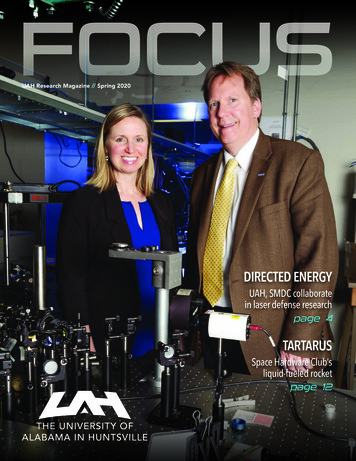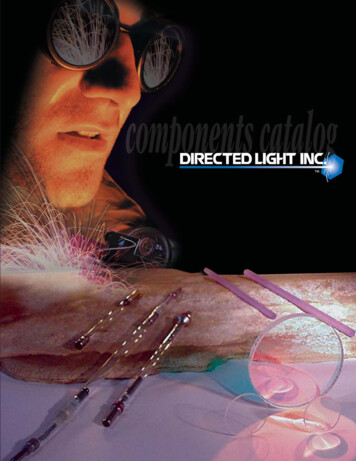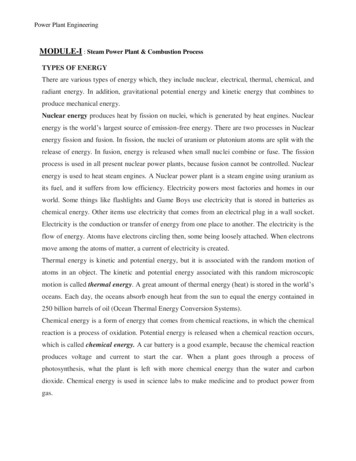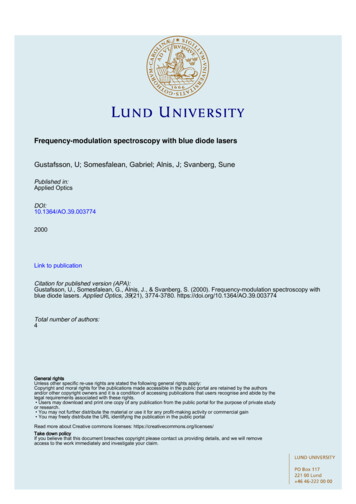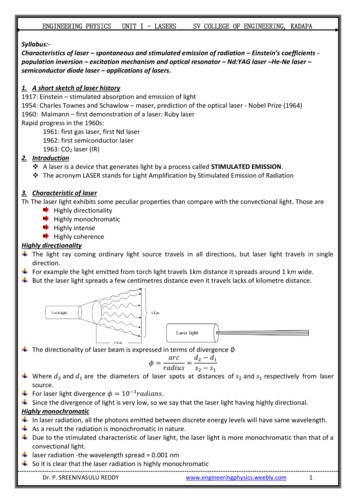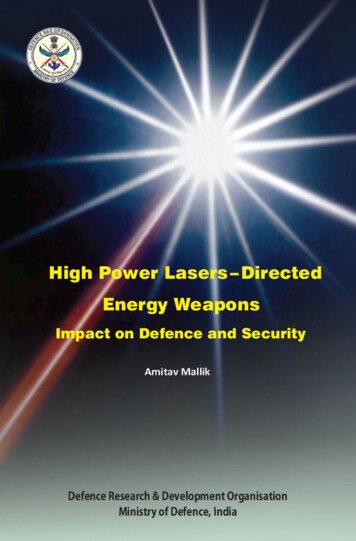
Transcription
High Power Lasers–Directed Energy WeaponsImpact on Defence and Security
High Power Lasers–Directed Energy WeaponsImpact on Defence and SecurityAmitav MallikFormer DirectorLaser Science and Technology Centre (LASTEC)Metcalfe House, DelhiDefence Research and Development OrganisationMinistry of Defence, New Delhi – 110 0112012
DRDO MONOGRAPHS/SPECIAL PUBLICATIONS SERIESHIGH POWER LASERS–DIRECTED ENERGY WEAPONS: IMPACT ONDEFENCE AND SECURITYAMITAV MALLIKSeries EditorsEditor-in-ChiefSK JindalAssociate Editor-in-ChiefDr GS MukherjeeEditorAnita AAsst. EditorKavita NarwalEditorial AssistantGunjan BakshiPrintingSK GuptaMarketingRajpal SinghCataloguing in PublicationMallik, AmitavHigh Power Laser–Directed Energy Weapons: Impact on Defence and SecurityDRDO Monographs/Special Publications Series.1. Weapon Systems2. Laser WeaponI. TitleII. Series623:454.93. Military Technology 2012, Defence Research & Development Organisation, New Delhi - 110 011.ISBN 978-81-86514-36-8All rights reserved. Except as permitted under the Indian Copyright Act 1957, no part of thispublication may be reproduced, distributed or transmitted, stored in a database or a retrievalsystem, in any form or by any means, electronic, mechanical, photocopying, recording, orotherwise, without the prior written permission of the Publisher.The views expressed in the book are those of the author only. The Editors or the Publisher do notassume responsibility for the statements/opinions expressed by the author.Designed, produced, and printed by Director, DESIDOC, Metcalfe House, Delhi - 110 054.
ContentsPrefaceAcknowledgementsList of AcronymsChapter 1: Directed Energy Weapons: An Introduction1.1 Directed Energy Weapons for Defence and Security1.2 Technology Development: History and Status1.3 Properties, Potential, and Applications1.4 Technology Advances: Relevance for India1.5 Opportunities and Priorities for Indiaixxixiii13579Chapter 2: Introduction to High Power Lasers2.1 Laser Basics and Unique Features2.2 Criteria for High Power Capability2.3 Laser Resonators and Beam Quality Considerations2.4 Types of High Power Lasers2.5 Directed Energy Applications of Lasers1319222535Chapter 3: hpl Sources and Developments3.1 CO2 Gas Dynamic Laser3.2 Chemical Lasers3.3 Solid State Lasers3.4 Free Electron and Fibre Lasers3.5 X-Ray and High Energy Pulsed Lasers4248586370Chapter 4: hpl Beam Control and Beam Effects4.1 HPL Beam Control and Beam Propagation4.2 HPL Beam Directing and Target Tracking4.3 Atmospheric Propagation and Adaptive Optics4.4 Impact of HPL on Military Targets4.5 Laser Power Beaming Applications4.6 HPL Diagnostics and Safety Issues757681889093
Chapter 5: Defence Applications5.1 DEW R&D and Current Status5.2 Laser Countermeasures and Battlefield Applications5.3 Airborne Laser Technology–Impact on Missile Defence5.4 Advanced Tactical Laser–Regional Security Implications99104109116Chapter 6: Strategic Applications6.1 HPL–DEW for Missile Defence6.2 HPL–DEW and Space Defence6.3 Impact of Dew on Nuclear Missile Deterrence6.4 Lasers for Homeland Security123129134136Chapter 7: Trends and Challenges7.1 Lasers in Modern Battlefield7.2 Advances in HPL–DEW Technology7.3 Lasers for Space Security and Debris Mitigation7.4 HPL–DEW Challenges for India7.5 Imperatives for Indigenous HPL–DEW Programme141144151152156viii
PrefaceLaser technology has been one of most fascinating discoveries of the 20th century.The laser device is unique in many ways, the most striking aspect being its extraordinarybrightness. This has caught the imagination of mankind towards realisation of theultimate ‘death ray’ weapon that could outmatch all other weapons. Directed energyweapons (DEW) using high power lasers (HPL) have indeed arrived and are about tomake a major impact on the strategies for future wars and on the ways technologicaldeterrence will play an important role in avoiding future wars.Directed energy weapons using HPL are a new generation of weapons that travelat the speed of light with unprecedented accuracy. This has opened up very interestingapplications hitherto not possible with conventional technologies. Worldwide R&D inHPL–DEW has demonstrated many successful tests to establish the technology withits promising potential for the future of defence and security.The aim of this monograph is to present an overview of this fascinating technologyin all its dimensions in simple language, so that this serves as an easy reference for thehighly complex subject that combines several disciplines to bring the science fictionlike concepts into real-life applications. The other focus of the monograph is to presentan analysis of the strategic impact of HPL–DEW in the context of strategic missiledefence and space security that may significantly affect the perceptions of deterrencein the world power balance equations.The narrative is divided into seven chapters; the first four chapters giving anintroduction to the subject and the HPL–DEW technology, and the fifth chapterdiscussing defence applications. The last two chapters present the strategic implicationand a quick recap of HPL–DEW technology including Indian perspective.Much of the matter in this monograph is from the author’s own notes and his longexperience in HPL technology. This monograph is not intended as a reference textbookbut is oriented to add to the understanding of HPL–DEW as a weapon and bring out itsimpact on defence and security.August 2012ixAmitav Mallik
AcknowledgementsMy sincere thanks are due to the CCR&D (ECS) of DRDO Headquarters for theinvitation to undertake this project to produce a Monograph on ‘High Power Lasers–Directed Energy Weapons: Impact on Defence and Security’. Sincere thanks are dueto Director, Defence Scientific Information and Documentation Centre (DESIDOC),Delhi for the ready cooperation and efficient support received in bringing out thismonograph.I must in particular thank Ms Alka Bansal and Ms Anita A, Head, MonographDivision of DESIDOC for the excellent support in every possible manner. I must thankthe library staff of DESIDOC for help with reference search and library support.My special thanks go to my friend and associate Dr BS Patel, for agreeing toreview the manuscript and give valuable suggestions.I write this monograph with many warm memories of all my colleagues andfriends in the high power laser technology field, without whom the success achieveda decade ago at Laser Science and Technology Centre, Delhi would not have beenpossible.Amitav Mallik
List of ACWairborne laseranti-ballistic missile defenceactive denial systemaccessible emission limitsAirborne Laser Laboratoryauto-laser pointing systemairborne laser testbedadaptive optical systemAir Force Research Laboratoryanti-satelliteadvanced technology concept demonstratorairborne tactical laseracquisition, tracking, pointing and fire controlairborne warning and control systemBeacon illuminatorballistic missile defenceBallistic Missile Defence Organisationballistic missile defence systembattle management systemclose combat laser weaponcharged couple devicecombustion drivenchemical lasercomputer numerical controlchemical oxygen iodine lasercaesium titanyl arsenatecontinuous wave
ELLFIREHELSTFHPFLHPLHPMHYLTEHYWNIAFICBMDepartment of Atomic EnergyDefense Advance Research Project Agencydirected energy weaponsdeuterium fluoridedifference frequency generationdirectional infrared countermeasureDepartment of Defensediode-pumped solid state laserDefence Research and Development OrganisationDefence Science CentreDepartment of Science and Technologyerbium-doped fibre laserelectromagnetic pulseelectro-optics countermeasureenergy recovery linacfission activated laser conceptFood and Drug Administrationfree electron laserfield-of-viewfull width at half-maximumgas dynamic lasergadolinium scandium gallium garnetheat affected zoneheat capacity laserheat capacity solid state laserhigh energy laserhigh energy laser experimentalehelicopter-launched fire and forgethigh energy laser system test facilityhigh power fibre laserhigh power laserhigh power microwaveshypersonic low temperaturehypersonic wedge nozzleIndian Air Forceintercontinental ballistic missilexiv
ion and communication technologyIsrael Defense Forceinfraredinfrared countermeasureIndian Space Research Organisationjoint high power solid state laserpotassium titanyl phosphatelarge advanced mirror programmelight amplification by stimulated emission of radiationLaser Science and Technology CentreLaser Associe’A une Tourelle Experimentalelaser dazzle sightlight emitting diodelaser guided bomblight detection and ranginglaser induced plasma channellow level laser guided bombLawrence Livermore National Laboratorylarge optics demonstration experimentlaser orbital debris removalline-of-sightlaser power beaminglong range acoustic devicelaser rangefinderlithium tri-boratemutually assured destructionman-portable air-defence systemsmissile alternative range target instrumentMissile Defense Agencymid-IR advanced chemical lasermultiple independent re-entry vehiclemaximum permissible exposureMissile Technology Control Regimemobile THELmobile test vehiclenavy ARPA chemical laserxv
ESBLSBL-IFXSDISDIOSHGSFGSLACSLBDneodymium-doped yttrium aluminium garnetneodymium-doped lithium yttrium fluorideNational Missile DefenseNaval Research Laboratoryoptical phase conjugationoptical parametric oscillatororbital space vehiclephase conjugate mirrorpraseodymium-doped fluoride fibre amplifierprogramme definition and risk reductionpulsed energy projectileprecision-guided munitionprecision-guided mortar munitionPeople’s Liberation ArmyPeople’s Republic of Chinapressure recovery systempointer tracker systemrocket, artillery and mortar defenceRussian Federal Nuclear Centerring laser gyroRevolution in Military Affairsrapid retargeting and precision pointingreactor pumped laserremotely piloted vehiclerubidium titanyl arsenaterubidium titanyl phosphatesequential discharge acoustic generatorself amplified spontaneous emmissionspace-based laserspace-based laser integrated flight experimentstrategic defense initiativeStrategic Defense Initiative Officesecond harmonic generationsum frequency generationStanford Linear Accelerator Centersea lite beam directorxvi
SLRS/N CLAYLRWMDsatellite laser rangingsignal/noise ratiosinglet oxygen generatorspace pointing integrated control experimentstimulated Raman scatteringspace and strategic defense commandsolid state heat capacity lasersolid state laserStandford Synchrotron Radiation Laboratorytransversely excited atmospheretactical high energy lasertrack illuminatortube-launched, optically-tracked, wire command data linkunmanned aerial vehicleUniversity of California, Los Angelesytterbium fibre laserweapon of mass destructionxvii
Chapter 1Directed Energy Weapons: An Introduction1.10 Directed Energy Weapons FOR DEFENCE AND SECURITYThe progress of science and technology has been closely linked to man’spursuit of electromagnetic spectrum towards higher frequencies as this has openedup new application potentials and enabled new capabilities for defence and security.After the early days use of radio frequency for communication, radar and microwaveshave opened up new avenues related to defence applications. Today, the decisiveimpact of technology on war and peace is much more pronounced than ever before.As we commence the 21st century, the perceptions of military might and defencepreparedness are changing significantly as compared to the last century which wasdominated by cold war.The cold war era was dominated by nuclear weapons and missile technology.More recently, satellite surveillance, information communication technologies(ICT), and precision strike capabilities have transformed the strategic doctrines fordefence and security around the world. Thus, 21st century is likely to be influenced bytechnologies that can either complement these capabilities or create new capabilitiesthat can out-match the winner technologies of the 20th century.While information technology and space technology are proving to be majorenablers for modern network centric warfare, another new technology emergingclearly as critical for 21st century is directed energy weapons (DEW). Sustained R&Dover past three to four decades and successful tests after overcoming many hurdlesand problems, have led the technology to a state of maturity that is likely to enabledeployment of new generation beam weapon systems. While high power lasers (HPL)and high power microwaves (HPM) have emerged as the two main options for theDEW technology, HPL technology has progressed rapidly and has a clear advantagefor long-range military applications. Directed energy weapons are revolutionary innature and thus have the potential to significantly influence the international powerbalance in the 21st century.Electromagnetic energy is known to travel at the speed of light to reach longdistances in a split second, and this aspect has always fascinated human mind over theages. One of the first uses of such energy against enemy was the use of mirrors by Greekwarriors to reflect sun rays into the eyes of the enemy to blind them before attacking them.
High Power Lasers–Directed Energy Weapons: Impact on Defence and SecurityOne is of course familiar with the mythological tales of the third eye of ‘Lord Shiva’(Indian deity) that could send a scorching beam of light to burn and destroy the evil.All such perceptions and early adaptations of the use of visible light energy were indeedprecursors to DEW. Ever since the discovery of laser (light amplification by stimulatedemission of radiation) in 1960, the real world has come very close to the sciencefiction images of bright light beams as the new generation weapon. HPL–DEW, todayis recognised as unique speed of light energy beam weapons using high power lasersthat can be precisely aimed to target over long strategic distances. Other DEW optionsinclude HPM and particle beams, but they are yet to mature to the level of HPL, whichis ready for direct use as a weapon system in modern warfare.While the technology today is still far from providing the ultimate death-raygun in the hands of a foot soldier, DEW as a platform-based weapon system is beingpursued by many advanced countries, albeit at varying levels of technology maturity.Invisible infrared (IR) lasers have been in use for IR countermeasures (IRCM)through much of the cold war period. These devices are aimed at blinding ordisabling enemy sensors in the visible or IR band to deny enemy the early advantageof accurate observation. More modern versions of IRCM capability include causingdazzle effects to weapon system operators or damaging the guidance sensorsonboard on enemy missiles or unmanned air vehicles (UAVs) to render themineffective. As threats become complex, the need to respond rapidly and accuratelywith minimum collateral damage will be very essential, and most defence and securityplanners envisage increasing use of DEW to meet this future challenge across the fullspectrum of modern warfare.The major boost to DEW came in 1983 from the strategic defense initiative (SDI)of the Regan era, when ‘Star War’ technologies were promoted with the promise ofmaking nuclear weapons obsolete. Billions of dollars have been spent for R&D inDEW, driven by the logic that advanced DEW capability should provide a paradigmshift in the perception of ‘strategic deterrence’ that need no longer depend so heavilyon nuclear-tipped missiles. While HPL technology made impressive progress andremained in the news, significant technological advances were also achieved in theareas of HPM as well as in particle beam technologies 1.Extensive research into DEW sources and the concurrent advances in beam directingtechnology have pushed technology envelop to the level where fully configured DEWsystems are now being designed and tested for imminent deployment. Advances inmaterial technology, information technology, and space-based capabilities of the21st century are also providing the right environment for growing demand for DEWsystems. The US Air Force project on airborne laser (ABL) is a classic example ofhow DEW technology is transforming into a formidable weapon system with hithertounthinkable military capabilities.Although some of the space-based laser weapon concepts, as espoused by theUS President in the SDI–Star War initiative have remained unrealised, the potentialof laser-based DEW for tactical air defence, anti-ballistic missile defence, andanti-satellite (A-SAT) applications is now beyond doubt, as proven by severalsuccessful HPL tests in the past two decades. While more advanced nations likeUSA and Russia in this field are already busy solving the final engineering issues foreffective deployment of such energy weapons, the technology levels needed for such2
Directed energy weapons using HPL are a new generation of weapons that travel at the speed of light with unprecedented accuracy. This has opened up very interesting applications hitherto not possible with conventional technologies. Worldwide R&D in HPL-DEW has demonstrated many successful tests to establish the technology with
